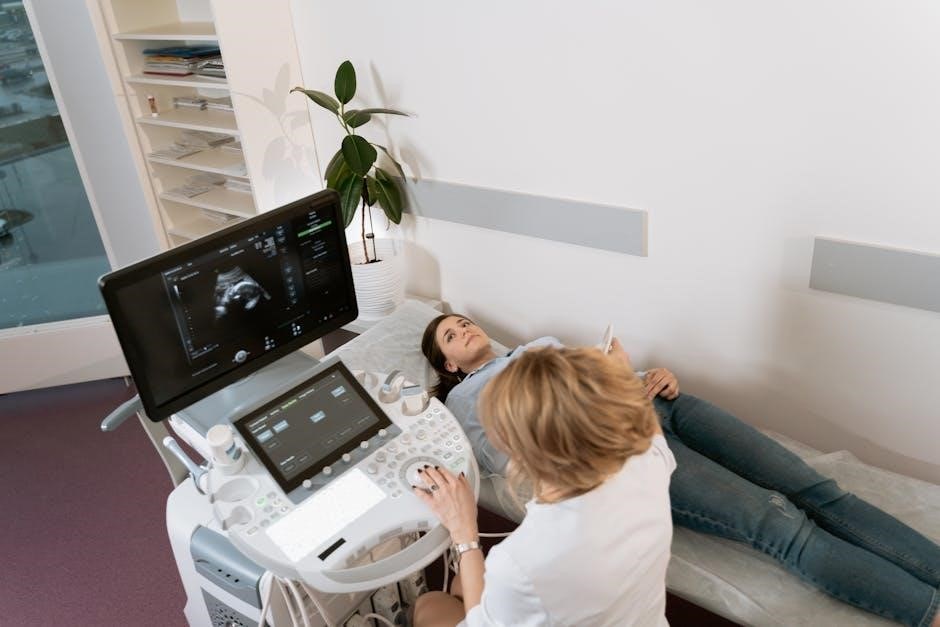The Denver Screening Test is a widely used tool to assess developmental progress in children aged 0-6 years. It evaluates gross motor, fine motor-adaptive, language, and personal-social skills, providing early insights into potential developmental delays. The test is not diagnostic but serves as a screening tool, guiding further evaluations when necessary. Its simplicity and effectiveness make it a valuable resource for professionals to identify early intervention needs.
Overview of the Denver Developmental Screening Test (DDST)
The Denver Developmental Screening Test (DDST) is a standardized tool designed to assess developmental progress in children from birth to six years. It evaluates four key domains: gross motor, fine motor-adaptive, language, and personal-social skills. The test is administered through a combination of observation, interview, and direct assessment, taking approximately 15-20 minutes. While it is not diagnostic, the DDST identifies potential delays, guiding further evaluations or interventions. Widely used by professionals, it is a valuable resource for early detection and support in developmental challenges.
Importance of Early Developmental Screening
Early developmental screening is crucial for identifying potential delays in children’s growth and development. It enables timely interventions, improving long-term outcomes for children with delays. The Denver Screening Test plays a key role in this process by providing insights into a child’s developmental status across multiple domains. Early detection allows parents, educators, and healthcare providers to address challenges promptly, ensuring children receive appropriate support. This proactive approach fosters healthier development and prepares children for future success.

Key Domains Assessed by the Denver Screening Test
The Denver Screening Test evaluates four main developmental areas: gross motor, fine motor-adaptive, language, and personal-social skills. These domains provide a comprehensive overview of a child’s development.
Gross Motor Skills
The Denver Screening Test assesses gross motor skills, focusing on large muscle movements like sitting, standing, walking, and balance. These abilities are crucial for physical coordination and overall mobility. The test evaluates how well a child can perform tasks such as crawling, running, and jumping, comparing their performance to age-specific norms. Early identification of delays in gross motor skills can guide interventions to support physical development. This domain is essential for understanding a child’s ability to navigate their environment effectively.
The Denver Screening Test evaluates fine motor and adaptive skills, which involve precise movements and coordination of small muscles. Tasks include using utensils, drawing, and manipulating objects, reflecting a child’s dexterity and hand-eye coordination. Adaptive skills, such as dressing and feeding, are also assessed to gauge independence and practical abilities. This domain helps identify delays in intricate movements and daily functioning, providing insights into a child’s capacity for self-care and detailed tasks. Early detection can prompt targeted support for skill development. The Denver Screening Test assesses language skills, focusing on both expressive and receptive abilities. It evaluates vocabulary, comprehension, and communication milestones, such as babbling, naming objects, and forming sentences. This domain helps identify delays in verbal and non-verbal communication, which are critical for social interaction and cognitive development. Early detection of language difficulties can lead to timely interventions, supporting improved communication and overall developmental outcomes for children. The test provides a clear framework to monitor language progression in early childhood. The Denver Screening Test evaluates personal-social skills, focusing on emotional development, self-awareness, and interpersonal interactions. It assesses milestones like smiling, waving, and showing affection, as well as independence and self-care abilities. This domain helps identify delays in social-emotional growth, which are essential for building relationships and self-esteem. Early detection of challenges in this area can guide interventions, promoting healthy social and emotional development in children. The test provides insights into a child’s ability to interact and function within their social environment. The Denver II assesses developmental progress in children aged 0-6 years, focusing on gross motor, fine motor-adaptive, language, and personal-social skills. It is a screening tool, not diagnostic, requiring further evaluation if results indicate delays. The test is administered through interviews and skill demonstrations, providing insights into developmental milestones and early intervention needs.
The Denver II is a developmental screening test designed for children from birth to six years. Its primary purpose is to identify children at risk of developmental delays. The test assesses four key domains: gross motor, fine motor-adaptive, language, and personal-social skills. It is not diagnostic but serves as an early warning system, guiding further evaluations. The Denver II helps professionals determine if a child’s development aligns with age norms, ensuring timely interventions. This tool supports early identification of potential issues. The Denver II consists of 125 items divided into four domains: gross motor, fine motor-adaptive, language, and personal-social skills. It is designed for children aged 0 to 6 years and takes 10-15 minutes to administer. The test is conducted through a combination of observation and parent/caregiver interviews. Items are presented in a developmental sequence, with specific tasks like drinking from a cup or drawing. The structure ensures a comprehensive assessment of a child’s abilities, providing a clear framework for evaluating developmental milestones effectively. The Denver II uses a scoring system based on age norms, where each item is marked as “pass” or “fail.” Results are compared to standardized norms, with specific cutoff points indicating potential delays. If a child fails items significantly below the expected range, further evaluation is recommended. The test is not diagnostic but serves as an early indicator of developmental concerns. Scoring is straightforward, and results are interpreted to guide early intervention and referrals for comprehensive assessments when necessary. This approach ensures timely identification of potential developmental issues. The Denver Screening Test was created by William K. Frankenburg and Josiah B. Dodds in 1967. It was later updated to the Denver II in 1992, enhancing its effectiveness in assessing child development. The test has since become a widely used tool globally for early developmental screening. The Denver Developmental Screening Test (DDST) was created by William K. Frankenburg and Josiah B. Dodds in 1967 in Denver, USA. It aimed to provide a simple method for identifying developmental delays in infants and preschool children. The test was designed to assess personal-social, fine motor-adaptive, language, and gross motor skills. Initially, it gained popularity as a straightforward tool for early detection of developmental issues. Over time, it evolved into the Denver II, further refining its effectiveness in assessing child development. The Denver Developmental Screening Test evolved into the Denver II in 1992, refining its structure and administration. This updated version incorporated improved age norms and expanded the assessment to cover children up to six years old. The Denver II retains the core domains of its predecessor but enhances accuracy and reliability. It includes 125 items divided into four sections: gross motor, fine motor-adaptive, language, and personal-social skills. This evolution ensures the test remains a vital tool for early developmental screening and intervention. The Denver Screening Test is administered via a 10-15 minute interview and skill demonstration. It includes 125 items assessing four developmental domains. Scoring is based on age norms, providing clear guidelines for identifying delays and guiding early interventions. Professionals and parents can use this structured approach to ensure accurate and reliable results. The Denver Screening Test is administered through a structured interview and observation of the child’s skills. The process involves 125 items divided into four developmental domains: gross motor, fine motor-adaptive, language, and personal-social skills. Trained professionals conduct the test, which typically lasts 10-15 minutes. The child demonstrates tasks like drawing, walking, or identifying objects, while parents or caregivers provide additional information. The format ensures a comprehensive assessment of the child’s developmental progress, allowing for early identification of potential delays. The Denver Screening Test scores are determined by comparing a child’s performance to age-specific norms. Each of the 125 items is evaluated based on whether the skill is present, emerging, or absent. The results are categorized into four domains: gross motor, fine motor-adaptive, language, and personal-social skills. Scores are interpreted using standardized age norms, with cut-off points indicating whether a child’s development is within typical expectations or if further evaluation is recommended. This approach ensures accurate and age-appropriate assessment of developmental milestones. This section highlights real-life applications of the Denver Screening Test, showcasing how it identifies developmental delays and guides interventions. Practical examples demonstrate its effectiveness in early detection and support. The Denver II is a practical tool for assessing developmental progress in children aged 0-6 years. It evaluates four key domains: gross motor, fine motor-adaptive, language, and personal-social skills. Professionals use it to identify delays and guide early interventions. The test is administered through interviews and skill demonstrations, making it accessible for various settings. Its concise structure allows for quick assessments, typically within 10-15 minutes, providing valuable insights for parents and healthcare providers. This tool supports timely referrals and monitoring of developmental progress. The Denver II is often used in clinical and educational settings to identify developmental delays. For instance, a child scoring below the 10th percentile may indicate a need for further evaluation. In one case, a 24-month-old child showed delayed fine motor skills, prompting early intervention. Such real-life applications highlight the test’s effectiveness in detecting issues early, enabling timely support and improving developmental outcomes. These scenarios underscore the tool’s practical value in fostering healthy child development. The Denver Screening Test is a vital tool for early detection of developmental delays in children aged 0-6 years, aiding in timely referrals and interventions. The Denver Screening Test plays a crucial role in early intervention by identifying children at risk of developmental delays. Positive results prompt referrals to specialists for further evaluation and tailored support. This ensures timely access to therapies and programs, improving long-term outcomes. Early detection is key to addressing challenges in motor, language, or social skills, fostering healthier development and enhancing the child’s quality of life through targeted interventions. The Denver Screening Test is a valuable tool for monitoring a child’s developmental progress over time. It assesses milestones in gross motor, fine motor-adaptive, language, and personal-social skills, providing insights into a child’s growth. By tracking developmental patterns, professionals can identify delays early and ensure timely interventions. Regular assessments with the Denver II help measure progress, allowing for adjustments in support strategies. This structured approach ensures consistent monitoring and informed decision-making for children from birth to 6 years. The Denver II stands out for its focus on early detection, assessing four key domains in children aged 0-6. Unlike other tests, it emphasizes quick screening and accessibility for professionals and parents, making it a preferred tool for early intervention planning. Its structured approach ensures comprehensive yet efficient evaluations, distinguishing it from more complex assessments like the Bayley Scales. The Denver II and Bayley Scales are both developmental assessments but differ in scope and purpose. The Denver II is a screening tool focusing on four domains in children aged 0-6, emphasizing early detection and quick administration. In contrast, the Bayley Scales provide a comprehensive diagnostic evaluation for children aged 0-42 months, covering cognitive, motor, and language skills in greater depth. While the Denver II is faster and more accessible, the Bayley Scales offer detailed insights for clinical assessments. The Denver II stands out for its age-specific norms and quick administration, typically completed in 10-15 minutes. It uniquely combines observation and parent-reported data, enhancing accuracy. Its focus on four key developmental domains—gross motor, fine motor-adaptive, language, and personal-social skills—provides a comprehensive yet concise assessment. The test’s design allows non-specialists to administer it effectively, making it accessible for widespread use in pediatric and educational settings. Its emphasis on early detection ensures timely intervention for children at risk of developmental delays. The Denver Screening Test User Manual provides a comprehensive guide for administering and interpreting the test. It includes detailed instructions, age norms, and scoring guidelines to ensure accurate assessments. The manual is essential for professionals to understand the test’s structure and effectively use it in clinical and educational settings to identify developmental delays in children aged 0-6 years. The Denver Screening Test User Manual serves as a detailed guide for administering and interpreting the test. It includes instructions for installation, operation, and scoring, ensuring accurate assessments. The manual outlines the test’s structure, age norms, and guidelines for evaluating developmental progress in children aged 0-6 years. Professionals can use it to identify delays and plan interventions effectively, making it an essential resource for both clinical and educational settings. The Denver Screening Test II manual provides clear guidelines for administration, emphasizing a quiet environment and age-appropriate engagement. The test should be administered by trained professionals, taking 10-15 minutes to complete. Scoring is based on age norms, with results guiding further evaluations. It’s essential to use standardized procedures to ensure accuracy. The manual also stresses the importance of interpreting results within the child’s developmental context, ensuring timely referrals for early intervention when needed. The Denver II has limitations, including reliance on age norms that may not account for cultural or individual variations. It is a screening tool, not diagnostic, requiring skilled administrators for accurate results. Environmental factors and the child’s cooperation can influence outcomes. Additionally, it may miss subtle developmental issues, emphasizing the need for comprehensive follow-up evaluations when concerns arise. Proper training and understanding of its scope are crucial for effective use. The Denver II is a screening tool, not diagnostic, and may miss subtle developmental issues. It relies on age norms that do not account for cultural or individual variations. Environmental factors and the child’s cooperation can significantly influence results. Skilled administrators are required for accurate assessments. Additionally, it may not detect mild delays or specific conditions, necessitating comprehensive follow-up evaluations. These limitations highlight the importance of using the Denver II as part of a broader developmental assessment strategy. The accuracy of the Denver II can be influenced by several factors, including the child’s cultural background, socioeconomic status, and environmental experiences. The examiner’s skill level and interpretation of results also play a critical role. Additionally, the child’s mood, cooperation, and test conditions can impact performance. Cultural biases in the test design may affect outcomes for diverse populations. These factors highlight the importance of standardized administration and trained professionals to ensure reliable and valid results. Future advancements may include integrating digital tools for easier administration and expanding the test to cover a broader age range and cultural adaptability, enhancing accuracy and accessibility. Recent advancements in developmental screening include the integration of digital tools for remote assessments and real-time data analysis. Expanding the age range and cultural adaptability of screening tests like the Denver II is a priority. Incorporating artificial intelligence and machine learning can enhance predictive accuracy and early detection of delays. These innovations aim to improve accessibility and reliability, ensuring timely interventions for children worldwide. Continuous updates and validations are crucial to maintain the test’s effectiveness in diverse populations and evolving developmental understanding. Possible enhancements to the Denver II include expanding its age range, incorporating digital tools for remote assessments, and improving cultural adaptability. Adding more items to assess emerging skills, such as emotional regulation and cognitive abilities, could provide a more comprehensive evaluation. Enhancing the test’s sensitivity to detect subtle developmental delays and integrating artificial intelligence for predictive analytics are also potential advancements. These improvements would ensure the Denver II remains a robust and versatile tool for early developmental screening in diverse populations.Fine Motor-Adaptive Skills
Language Skills
Personal-Social Skills

Understanding the Denver Screening Test II (Denver II)
Definition and Purpose
Structure and Administration
Scoring and Interpretation

History and Development of the Denver Screening Test
Creators and Initial Development
Evolution to Denver II
Administration and Scoring Guidelines
Test Administration Process
Scoring Based on Age Norms

Case Studies and Examples
Practical Applications of the Denver II
Real-Life Scenarios and Results
Clinical Applications and Implications
Early Intervention and Referral
Monitoring Developmental Progress

Comparative Analysis with Other Developmental Tests
Denver II vs. Bayley Scales of Infant and Toddler Development
Unique Features of the Denver II
Denver Screening Test User Manual
Contents and Purpose of the Manual
Guidelines for Effective Use
Limitations and Considerations
Potential Drawbacks of the Denver II
Factors Influencing Test Accuracy

Future Directions and Improvements
Advancements in Developmental Screening
Possible Enhancements to the Denver II



